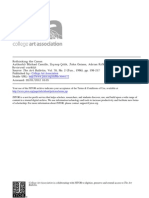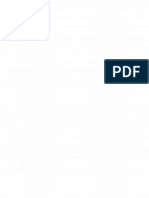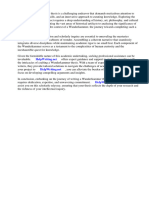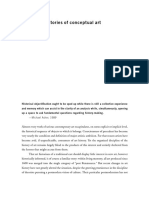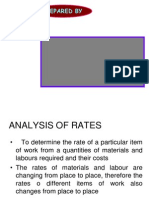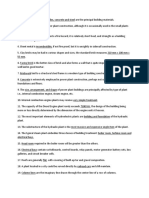On The Museums Ruins PDF
On The Museums Ruins PDF
Uploaded by
AleksandraCopyright:
Available Formats
On The Museums Ruins PDF
On The Museums Ruins PDF
Uploaded by
AleksandraOriginal Title
Copyright
Available Formats
Share this document
Did you find this document useful?
Is this content inappropriate?
Copyright:
Available Formats
On The Museums Ruins PDF
On The Museums Ruins PDF
Uploaded by
AleksandraCopyright:
Available Formats
On the Museum's Ruins
Author(s): Douglas Crimp
Source: October, Vol. 13 (Summer, 1980), pp. 41-57
Published by: The MIT Press
Stable URL: http://www.jstor.org/stable/3397701 .
Accessed: 15/01/2014 15:15
Your use of the JSTOR archive indicates your acceptance of the Terms & Conditions of Use, available at .
http://www.jstor.org/page/info/about/policies/terms.jsp
.
JSTOR is a not-for-profit service that helps scholars, researchers, and students discover, use, and build upon a wide range of
content in a trusted digital archive. We use information technology and tools to increase productivity and facilitate new forms
of scholarship. For more information about JSTOR, please contact support@jstor.org.
The MIT Press is collaborating with JSTOR to digitize, preserve and extend access to October.
http://www.jstor.org
This content downloaded from 128.151.244.46 on Wed, 15 Jan 2014 15:15:24 PM
All use subject to JSTOR Terms and Conditions
On the Museum's Ruins
DOUGLAS CRIMP
The Germanwordmuseal [museumlike]
has unpleasant overtones. It describes
objects to which the observerno longer
has a vital relationshipand which are in
the process of dying. They owe their
preservationmore to historical respect
than to theneedsof thepresent.Museum
and mausoleum are connectedby more
than phonetic association. Museums are
like thefamilysepulchresofworksofart.
-Theodor W. Adorno, "Valery Proust
Museum"
In his review of the new installation of nineteenth-century art at the
MetropolitanMuseum, Hilton Kramerattackstheinclusion of salon painting in
the Andre Meyer Galleries. Characterizingthat art as silly, sentimental,and
impotent, Kramer goes on to assert that, had the reinstallationbeen done a
generationearlier,such pictureswould have remained in the museum's store-
rooms, to which theyhad so justly been consigned:
This content downloaded from 128.151.244.46 on Wed, 15 Jan 2014 15:15:24 PM
All use subject to JSTOR Terms and Conditions
42 OCTOBER
It is the destiny of corpses, afterall, to remain buried, and salon
painting was found to be verydead indeed.
But nowadays thereis no artso dead thatan arthistoriancannot
be found to detectsome simulacrumof lifein itsmolderingremains.In
the last decade, there has, in fact,arisen in the scholarly world a
powerfulsub-professionthat specializes in these lugubrious disinter-
ments.1
Kramer'smetaphorofdeathand decayin themuseumrecallsAdorno'sessay,
in which theopposite but complementaryexperiencesof Valeryand Proustat the
Louvre are analyzed,except thatAdorno insistsupon this museal mortalityas a
necessaryeffectof an institutioncaught in the contradictionsof its cultureand
thereforeextendingto everyobject contained there.2Kramer,on the otherhand,
retaininghis faithin theeternallifeofmasterpieces,ascribestheconditionsof life
and death not to the museum or the particular history of which it is an
instrument, but to artworksthemselves,theirautonomous quality threatenedonly
by the distortionsthat a particular misguided installation might impose. He
thereforewishes to explain "this curious turnaboutthat places a meretricious
little picture like Gerome's 'Pygmalion and Galatea' under the same roof with
masterpieceson theorderof Goya's 'Pepito' and Manet's 'Woman with a Parrot.'
What kind of tasteis it-or what standardof values-that can so easilyaccommo-
date such glaring opposites?"
The answer [Kramer thinks] is to be found in that much-discussed
phenomenon-the death of modernism. So long as the modernist
movementwas understoodto be thriving,therecould be no question
about a revival of painters like Ger6me or Bouguereau. Modernism
exerteda moral as well as an estheticauthoritythatprecludedsuch a
development.But thedemise of modernismhas leftus with few,ifany,
defensesagainst the incursionsof debased taste.Under the new post-
modernistdispensation,anythinggoes....
It is as an expressionof thispost-modernist
ethos ... thatthenew
installation of 19thcenturyart at the Met needs ... to be understood.
What we are given in the beautifulAndre MeyerGalleries is the first
comprehensiveaccount of the 19th centuryfrom a post-modernist
point of view in one of our major museums.3
We have hereyetanotherexample of Kramer'smoralizingculturalconserva-
tism disguised as progressivemodernism. But we also have a veryinteresting
1. Hilton Kramer,"Does Ger6me Belong with Goya and Monet?" New York Times, April 13,
1980,section2, p. 35.
2. Theodor W. Adorno, "Valery Proust Museum," Prisms, trans. Samuel and ShierryWeber,
London, Neville Spearman, 1967,pp. 173-186.
3. Kramer,p. 35.
This content downloaded from 128.151.244.46 on Wed, 15 Jan 2014 15:15:24 PM
All use subject to JSTOR Terms and Conditions
On the Museum's Ruins 43
puzzle, whose pieces are not, in my estimation,fittedtogetherright,perhaps
because a crucial one is missing. The pieces Kramer has assembled are the
museum, art history,modernism,and postmodernism.To which I would add
photography,and complete the puzzle to look, I would say, somethinglike this:
For I want to claim thatRauschenberg'sart,using the medium of photography
and at the thresholdof postmodernism,enactsa deconstructionof thediscourseof
the museum, of its pretensionsto anythingwe could possibly call knowledge.
RobertRauschenberg.Transom. 1963.
This content downloaded from 128.151.244.46 on Wed, 15 Jan 2014 15:15:24 PM
All use subject to JSTOR Terms and Conditions
44 OCTOBER
One of theearlyinstancesof thetermpostmodernismas applied to thevisual
arts occurs in Leo Steinberg's"Other Criteria,"in the course of a discussion of
Rauschenberg's work and its transmutationof the picture surface into what
Steinbergcalls a flatbed,referring, to a printingpress.4This flatbed
significantly,
picture plane is an altogether new kind of picture surface,one that effects,
accordingto Steinberg,a radical shiftfromnatureto culture.That is, it is a surface
which can receivea vast and heterogeneousarrayof culturalimages and artifacts
that had not been compatible with the pictorial fieldof eitherpremodernistor
modernistpainting. (A modernistpainting retainsa "natural" orientationto the
spectator'svision, which the postmodernistpicture abandons.) Although it is
doubtful that Steinberghad a veryprecise notion of the far-reachingimplica-
tions of his termpostmodernism,a termnow used extremelypromiscuously,his
reading of the revolutionimplicitin Rauschenberg'sartcan be both focusedand
extendedby takingthis designationseriously.
Presumably unconsciously, Steinberg'sessay suggests importantparallels
with the "archeological" enterpriseof Michel Foucault. Not only does the very
term postmodernismimply the foreclosureof what Foucault would call the
episteme,or archive,of modernism,but even more specifically, by insistingupon
theradicallydifferent kindsof picturesurfacesupon which different kindsofdata
can be accumulated and organized,SteinbergselectstheveryfigurethatFoucault
uses to representthe incompatibilityof historicalperiods: the tablesupon which
theirknowledgeis tabulated.
Foucault's project involves the replacementof those unities of humanist
historicaldiscourse such as tradition,influence,development,evolution,source,
and origin with concepts like discontinuity,rupture,threshold,limit,series,and
transformation.Thus, in Foucault's terms,if the surfaceof a Rauschenberg
painting trulyinvolves the kind of transformation thatSteinbergclaims it does,
then it cannot be said to evolve from,or in any way be continuous with a
modernistpicturesurface.5And if Rauschenberg'sflatbedpicturesare experienced
as effectingsuch a ruptureor discontinuitywith themodernistpast, as I believe
theydo, and as I thinkdo the works of many other artistsof the present,then
perhaps we are indeed experiencingone of those cataclysmicrupturesin the
epistemologicalfieldthatFoucault describes,a ruptureas thoroughas thatwhich
separatestheage of classicism(the seventeenthand eighteenthcenturies)fromthe
age of modernism,the analysis of wealth fromeconomics,natural historyfrom
biology, general grammar from philology.6 But it is not, of course, only the
4. Leo Steinberg,"Other Criteria,"OtherCriteria,New York,OxfordUniversityPress, 1972,pp.
55-91. This essay is based on a lecturepresentedat the Museum of ModernArt,New York,in March
1968.
5. See Rosalind Krauss's discussion of the radical differencebetween cubist collage and
Rauschenberg's "reinvented" collage in "Rauschenberg and the Materialized Image," Artforum,
XIII, 4 (December 1974), 36-43.
6. These are the subjects analyzed by Foucault in The Order of Things, New York, Pantheon,
1970.
This content downloaded from 128.151.244.46 on Wed, 15 Jan 2014 15:15:24 PM
All use subject to JSTOR Terms and Conditions
On the Museum's Ruins 45
epistemological field that is unrecognizablytransformed at certainmomentsin
history.New institutionsof power, as well as new discourses,arise;indeed thetwo
are interdependent.Foucault has concentratedon moderninstitutionsofconfine-
ment: the asylum, the clinic, and theprison; forhim, it is theseinstitutionsthat
produce the respectivediscourses of madness, illness, and criminality-not the
otherway around. There is anotherinstitutionof confinement ripe foranalysisin
Foucault's terms:the museum; and another discipline: art history.They are,
togetherwithphotography,or perhaps morepreciselytherepressionand selective
use of photography,the preconditionsof the discoursethatwe call modernart.
Foucault himselfhas hintedat the way to begin thinkingabout this analysis.
The beginningof modernismin painting is usually located in Manet's work
of theearlysixties,in which painting'srelationshipto itsart-historical
precedents
was made shamelessly obvious. Titian's Venus of Urbino is meant to be as
recognizablea vehicle forthepictureof a moderncourtesanin Manet's Olympia
as is the unmodeled pink paint thatcomposes her body. Justone hundredyears
afterManet problematizedpainting's relationship to its sources,7Rauschenberg
made a series of pictures using the images of Velazquez's Rokeby Venus and
Rubens's Venus at Her Toilet. But Rauschenberg'sreferencesto theseold-master
paintings is effected
entirelydifferentlyfromManet's; while Manet duplicates the
pose, composition,and certaindetails of theoriginal in a painted transformation,
Rauschenberg simply silkscreensa photographic reproductionof the original
onto a surfacethatmightalso contain such images as trucksand helicopters.And
if trucksand helicopterscannothave foundtheirway onto thesurfaceof Olympia,
it is obviouslynot only because such productsof themodernage had not yetbeen
invented.More crucially,it is because of the structuralcoherencethat made an
image-bearingsurface legible as a picture at the thresholdof modernism,as
7. Of course, not all art historianswould agree that Manet problematizedthe relationshipof
painting to its sources.This is, however,the initial assumptionof Michael Fried's "Manet's Sources:
Aspectsof his Art,1859-1865"(Artforum, VII, 7 [March 1969],28-82), whose firstsentencereads: "If a
single question is guiding forour understandingof Manet's artduringthefirsthalfof the 1860s,it is
this:What are we to make of thenumerousreferences in his paintingsof thoseyearsto theworkof the
greatpaintersof thepast?" (p. 28). In part,Fried'spresuppositionthatManet's references to earlierart
were different,in their"literalnessand obviousness," fromthe ways in which Westernpainting had
previously used sources led Theodore Reff to attack Fried's essay, saying, for example, "When
Reynolds portrayshis sittersin attitudesborrowedfromfamous picturesby Holbein, Michelangelo,
and Annibale Carracci,wittilyplaying on theirrelevanceto his own subjects;when Ingresdeliberately
refersin his religious compositionsto those of Raphael, and in his portraitsto familiarexamplesof
Greeksculptureor Roman painting,do theynot revealthe same historicalconsciousnessthatinforms
Manet's earlywork?" (Theodore Reff,"'Manet's Sources': A Critical Evaluation," Artforum, VIII, 1
[September1969], 40). As a result of this denial of difference, Reffis able to continue applying to
modernismart-historicalmethodologiesdevised to explain past art,forexample thatwhich explains
the veryparticularrelationshipof Italian Renaissance art to the art of classical antiquity.
This content downloaded from 128.151.244.46 on Wed, 15 Jan 2014 15:15:24 PM
All use subject to JSTOR Terms and Conditions
46 OCTOBER
RobertRauschenberg.Crocus. 1962.
This content downloaded from 128.151.244.46 on Wed, 15 Jan 2014 15:15:24 PM
All use subject to JSTOR Terms and Conditions
On theMuseum's Ruins 47
opposed to the radicallydifferent pictorial logic thatobtains at thebeginningof
postmodernism. Just what it is that constitutesthe particular logic of a Manet
painting is discussed in an essay by Foucault about Flaubert's Temptationof St.
Anthony:
Dejeuner sur l'Herbe and Olympia were perhaps the first"museum"
paintings, the firstpaintings in European art thatwere less a response
to the achievementof Giorgione, Raphael, and Velazquez than an
acknowledgement(supportedby thissingularand obvious connection,
using this legible referenceto cloak its operation) of the new and
substantialrelationshipof painting to itself,as a manifestationof the
existenceof museums and the particularrealityand interdependence
thatpaintings acquire in museums. In the same period, The Tempta-
tion was thefirstliterarywork to comprehendthegreenishinstitutions
where books are accumulated and where the slow and incontrovert-
ible vegetationof learningquietlyproliferates.Flaubertis to thelibrary
what Manet is to the museum. They both produced works in a self-
conscious relationship to earlier paintings or texts-or ratherto the
aspect in painting or writingthatremainsindefinitely open. They erect
their art within the archive. They were not meant to foster the
lamentations-the lost youth,the absence of vigor,and the decline of
inventiveness-throughwhich we reproachour Alexandrian age, but
to unearth an essential aspect of our culture: everypainting now
belongs within the squared and massive surfaceof painting and all
literaryworksare confinedto the indefinitemurmurof writing.8
At a later point in this essay, Foucault says that "Saint Anthonyseems to
summon Bouvard and Pecuchet,at least to the extentthat the latterstandsas its
grotesque shadow." If The Temptation points to the libraryas the generatorof
modernliterature,thenBouvard and Pecuchetfingersit as thedumping grounds
of an irredeemableclassical culture. Bouvard and Pecuchet is a novel that
systematically parodies the inconsistencies,irrelevancies,the massive foolishness
of receivedideas in themid-nineteenth century.Indeed a "Dictionaryof Received
Ideas" was to comprise part of a second volume of Flaubert's last, unfinished
novel.
Bouvard and Pecuchet is thenarrativeof two loony Parisian bachelorswho,
at a chance meeting,discoverbetweenthemselvesa profoundsympathy,and also
that theyare both copy clerks.They share a distasteforcitylifeand particularly
for their fate of sitting behind desks all day. When Bouvard inheritsa small
fortunethe two buy a farmin Normandy,to which theyretire,expectingthereto
8. Michel Foucault, "Fantasia of the Library," Language, Counter-Memory,Practice, trans.
Donald F. Bouchard and SherrySimon, Ithaca, Cornell UniversityPress, 1977,pp. 92-93.
This content downloaded from 128.151.244.46 on Wed, 15 Jan 2014 15:15:24 PM
All use subject to JSTOR Terms and Conditions
48 OCTOBER
meet head on the realitythat was denied them in the half-lifeof theirParisian
offices.
They begin with theidea thattheywill farmtheirfarm,at which theyfail
miserably.From agriculturetheymove to a more specialized field:arboriculture.
Failing thattheydecide upon gardenarchitecture. To preparethemselvesforeach
of theirnew professions,theyconsultvariousmanuals and treatises,in which they
are extremelyperplexed to findcontradictionsand misinformationof all kinds.
The advice theyseek in them is eitherconfusingor utterlyinapplicable; theory
and practicenevercoincide. But undauntedby theirsuccessivefailures,theymove
on inexorablyto thenextactivity,only to findthatit too is incommensuratewith
the textswhich purportto representit. They trychemistry, physiology,anatomy,
geology, archeology... the list goes on. When theyfinallysuccumb to the fact
that the knowledge they've relied upon is a mass of contradictions,utterly
haphazard, and quite disjunct fromthe realitythey'dsought to confront,they
revertto theirinitial taskof copying. Here is one of Flaubert'sscenarios forthe
end of the novel:
They copy papers haphazardly,everythingtheyfind,tobacco pouches,
old newspapers,posters,tornbooks, etc. (real items and theirimita-
tions. Typical of each category).
Then, they feel the need for a taxonomy. They make tables,
antitheticaloppositions such as "crines of thekings and crimesof the
people"-blessings of religion,crimesof religion. Beauties of history,
etc.;sometimes,however,theyhave real problemsputtingeach thingin
its proper place and suffergreatanxietiesabout it.
-Onward! Enough speculation! Keep on copying! The page
must be filled.Everythingis equal, the good and the evil. The farcical
and thesublime-the beautifuland theugly-the insignificant and the
typical, they all become an exaltation of the statistical.There are
nothing but facts-and phenomena.
Final bliss.9
In a recentessay about the novel, Eugenio Donato argues persuasivelythat
the emblem for the series of heterogeneousactivitiesof Bouvard and Pecuchet
is not, as Foucault and others have claimed, the library-encyclopedia,but
ratherthe museum. This is not only because the museum is a privilegedtermin
the novel itself,but also because of the absolute heterogeneity
it gatherstogether.
The museum contains everythingthe librarycontains and it contains thelibrary
as well:
9. Quotedin EugenioDonato,"The Museum'sFurnace:NotesTowarda Contextual
Readingof
Bouvard and Pecuchet," Textual Strategies:Perspectivesin Post-Structuralist
Criticism,ed. Josui V.
Harari,Ithaca,CornellUniversity
Press,1979,p. 214.I wishto thankRosalindKraussforbringing
thisessayto myattention
and moregenerallyforourmanydiscussions of theissuesraisedhere.
This content downloaded from 128.151.244.46 on Wed, 15 Jan 2014 15:15:24 PM
All use subject to JSTOR Terms and Conditions
On theMuseum's Ruins 49
If Bouvard and Pecuchetneverassemblewhat can amount to a library,
theyneverthelessmanage to constitutefor themselvesa private mu-
seum. The museum,in fact,occupies a centralposition in thenovel; it
is connected to the characters'interestin archeology,geology, and
historyand it is thus throughthe Museum thatquestions of origin,
causality, representation,and symbolizationare most clearly stated.
The Museum, as well as thequestions it triesto answer,depends upon
an archeological epistemology. Its representationaland historical
pretensionsare based upon a number of metaphysicalassumptions
about origins-archeology intends, afterall, to be a science of the
arches.Archeologicalorigins are importantin two ways: each archeo-
logical artifacthas to be an original artifact,and theseoriginal artifacts
must in turn explain the "meaning" of a subsequent largerhistory.
Thus, in Flaubert's caricatural example, the baptismal font that
Bouvard and Pecuchet discoverhas to be a Celtic sacrificialstone,and
Celtic culture has in turn to act as an original master pattern for
cultural history.10
Not only do Bouvard and Pecuchet deriveall of Westernculture fromthe few
stonesthatremain fromtheCeltic past, but the"meaning" of thatcultureas well.
Those menhirslead them to constructthe phallic wing of theirmuseum:
In formertimes towers,pyramids,candles, milestonesand even trees
had a phallic significance,and forBouvard and Pecuchet everything
became phallic. They collected swing-poles of carriages,chair-legs,
cellar bolts, pharmacists'pestles. When people came to see themthey
would ask: 'What do you think that looks like?' then confidedthe
mystery,and if therewere objections, theyshrugged theirshoulders
pityingly.11
Even in this subcategoryof phallic objects,Flaubertmaintainstheheterogeneity
of the museum's artifacts,a heterogeneitywhich defiesthe systematizationand
homogenizationthatknowledgedemands.
The set of objects theMuseum displaysis sustainedonly by thefiction
thattheysomehowconstitutea coherentrepresentational universe.The
fictionis that a repeated metonymicdisplacement of fragmentfor
totality,object to label, series of objects to series of labels, can still
produce a representation which is somehow adequate to a nonlinguis-
10. Ibid., p. 220. The apparentcontinuitybetweenFoucault's and Donato's essayshereis mislead
ing, inasmuch as Donato is explicitlyengaged in an attackupon Foucault's archeologicalmethodol-
ogy,claiming thatit implicatesFoucault in a returnto a metaphysicsof origins.
11. Gustave Flaubert,Bouvard and Pecuchet,trans.A. J. Krailsheimer,New York,Penguin Books,
1976,pp. 114-115.
This content downloaded from 128.151.244.46 on Wed, 15 Jan 2014 15:15:24 PM
All use subject to JSTOR Terms and Conditions
50 OCTOBER
tic universe. Such a fictionis the resultof an uncriticalbelief in the
notion thatorderingand classifying,thatis to say, thespatial juxtapo-
sition of fragments,can produce a representationalunderstandingof
the world. Should the fictiondisappear, thereis nothing leftof the
Museum but "bric-a-brac," a heap of meaningless and valueless
fragmentsof objects which are incapable of substitutingthemselves
either metonymicallyfor the original objects or metaphoricallyfor
theirrepresentations.12
This perceptionof themuseum is what Flaubertfiguresthroughthecomedy
of Bouvard and Pecuchet. Founded on the disciplines of archeologyand natural
history,both inheritedfrom the classical age, the museum was a discredited
institutionfromits veryinception.And thehistoryofmuseologyis a historyof all
the various attemptsto deny the heterogeneity of the museum, to reduce it to a
homogeneous system or series. The faith in the possibility of ordering the
museum's "bric-a-brac,"echoing that of Bouvard and Pecuchet themselves,
persists until today. Reinstallations like that of the Andre Meyer Galleries,
particularlynumerous throughoutthe past decade, are testimoniesto that faith.
What so alarms Hilton Kramerin thisparticularinstanceis thatthecriterionfor
determiningthe orderof aestheticobjects in the museum throughoutthe era of
modernism-the "self-evident"quality of masterpieces-has been broken,and as
a result"anythinggoes." Nothing could speak moreeloquentlyof thefragility of
the museum's claims to representanythingcoherentat all.
In theperiod followingWorldWar II, perhaps thegreatestmonumentto the
museum's discourseis Andre Malraux's Museum WithoutWalls. If Bouvard and
Pecuchet is a parodyof receivedideas of themid-nineteenth century,theMuseum
Without Walls is the hyperboleof such ideas in the mid-twentieth. Specifically,
what Malraux unconsciouslyparodies is "arthistoryas a humanisticdiscipline."
For Malraux findsin the notion of stylethe ultimatehomogenizingprinciple,
indeed the essenceof art,hypostatized,interestingly enough, throughthemedium
of photography.Any work of art thatcan be photographedcan take its place in
Malraux's super-museum.But photographynot only secures the admittanceof
objects,fragments of objects,details,etc.,to themuseum,it is also theorganizing
device: it reduces the now even vasterheterogeneity to a single perfectsimilitude.
Through photographicreproduction a cameo takesup residenceon thepage next
to a painted tondo and a sculpted relief; a detail of a Rubens in Antwerpis
12. Donato, p. 223. No distinctionsare made in Donato's essay,nor in my own, betweenthe art
museum and its prototype,the natural historymuseum. The reasons for removingart to its own
special museum and the particularhistoryof thatinstitutionmust be the subject of anotheressay.
RobertRauschenberg.
Exile. 1962.
This content downloaded from 128.151.244.46 on Wed, 15 Jan 2014 15:15:24 PM
All use subject to JSTOR Terms and Conditions
This content downloaded from 128.151.244.46 on Wed, 15 Jan 2014 15:15:24 PM
All use subject to JSTOR Terms and Conditions
52 OCTOBER
compared to thatof a Michelangelo in Rome.The arthistorian'sslide lecture,the
art-historystudent'sslide comparisonexam belong in themuseumwithoutwalls.
In a recentexample provided by one of our most eminentart historians,the oil
sketchfora tinydetail of a cobblestonestreetin Paris-A Rainy Day, painted in
the 1870sbyGustaveCaillebotte,occupies theleft-handscreenwhile a paintingby
Robert Ryman from the Winsor series occupies the right;and presto! theyare
revealed to be one and the same.13But what kind of knowledge is it that this
artisticessence,style,can provide?Here is Malraux:
Reproduction has disclosed the whole of world's sculpture. It has
multiplied accepted masterpieces,promotedotherworks to theirdue
rank and launched some minor styles-in some cases, one mightsay,
inventedthem.It is introducingthelanguage of color into arthistory;
in our Museum withoutWalls picture,fresco,miniatureand stained-
glass window seem of one and the same family. For all alike-
miniatures,frescoes,stained glass, tapestries,Scythian plaques, pic-
tures,Greek vase paintings,"details" and even statuary-have become
"colorplates." In the process theyhave lost theirpropertiesas objects;
but, by the same token, they have gained something: the utmost
significanceas to stylethat theycan possibly acquire. It is hard forus
clearly to realize the gulf between the performanceof an Aeschylean
tragedy,with theinstantPersian threatand Salamis looming acrossthe
Bay, and the effect we get fromreadingit; yet,dimlyalbeit,we feelthe
difference.All that remains of Aeschylusis his genius. It is the same
with figuresthatin reproductionlose both theiroriginal significanceas
objects and their function(religious or other); we see them only as
works of art and theybringhome to us only theirmakers' talent.We
mightalmost call themnot "works" but "moments"of art.Yet diverse
13. This comparison was firstpresentedby RobertRosenblum in a symposiumentitled"Modern
Art and the Modern City: From Caillebotte and the Impressioniststo the PresentDay," held in
conjunction with the Gustave Caillebotte exhibition at the Brooklyn Museum in March 1977.
Rosenblum published a versionof his lecture,although only works by Caillebottewere illustrated.
The following excerpt will sufficeto give an impression of the comparisons Rosenblum drew:
"Caillebotte's art seems equally in tune with some of the structuralinnovations of recentnon-
figurativepainting and sculpture. His embracing,in the 1870s,of the new experienceof modern
Paris . . . involvesfreshways of seeing thatare surprisinglyclose to our own decade. For one, he seems
to have polarizedmorethanany ofhis Impressionistcontemporariestheextremities of therandomand
theordered,usually juxtaposing thesecontrarymodes in thesame work.Parisians in cityand country
come and go in open spaces, but within theirleisurelymovementsare gridsof arithmetic,technologi-
cal regularity.Crisscrossingor parallel patternsof steelgirdersmove with an A-A-A-Abeat along the
railingofa bridge.Checkerboardsofsquare pavementstonesmap out therepetitivegridsystemswe see
in Warhol or early Stella, Ryman or Andre.Clean stripes,as in Daniel Buren[l],suddenlyimpose a
cheerful,primaryestheticorderupon urban fluxand scatter."("Gustave Caillebotte:The 1970sand
the 1870s," Artforum,XV, 7 [March 1977], 52). When Rosenblum again presentedthe Ryman-
Caillebotte slide comparison in a symposiumon modernismat Hunter College thispast March,he
admittedthatit was perhaps what Panofskywould have called a pseudomorphism.
This content downloaded from 128.151.244.46 on Wed, 15 Jan 2014 15:15:24 PM
All use subject to JSTOR Terms and Conditions
On theMuseum's Ruins 53
as theyare, all theseobjects... speak for the same endeavor; it is as
though an unseen presence,the spiritof art,were urging all on the
same quest.... Thus it is that,thanksto theratherspecious unityim-
posed by photographic reproduction on a multiplicityof objects,
ranging from the statue to the bas-relief,from bas-reliefsto seal-
impressions,and fromtheseto the plaques of thenomads, a "Babylo-
nian style"seems to emergeas a real entity,not a mereclassification-
as something resembling, rather, the life-storyof a great creator.
Nothing conveysmore vividlyand compellinglythe notion of a des-
tiny shaping human ends than do the great styles,whose evolutions
and transformations seem like long scars that Fate has left,in pass-
ing, on the face of the earth.14
All theworksof what we call art,or at leastall of themthatcan be submitted
to the process of photographic reproduction,can take theirplace in the great
super-oeuvre,Artas ontological essence,creatednot by men but by Man. This is
the comforting"knowledge" to which the Museum Without Walls gives testi-
mony. And concomitantly,it is the deception to which art history,a discipline
now thoroughlyprofessionalized,is most deeply, if oftenunconsciously,com-
mitted.
But Malraux makes a fatal errornear the end of his Museum: he admits
withinits pages theverythingthathad constitutedits homogeneity;thatthingis
of coursephotography.So long as photographywas merelya vehiclebywhich art
objects enteredthemuseum,a certaincoherenceobtained. But once photography
itselfenters,an artobject among others,heterogeneity is reestablishedat theheart
of the museum; its pretentionsto knowledge are doomed. Even photography
cannot hypostatizestylefroma photograph.
In Flaubert's "Dictionaryof ReceivedIdeas" theentryunder"Photography"
reads, "Will make painting obsolete. (See DAGUERREOTYPE.)" And the entry
for "Daguerreotype" reads, in turn, "Will take the place of painting. (See
PHOTOGRAPHY.)""5 No one took seriously the possibility that photography might
usurp painting. Less than half a centuryatterphotography'sinventionsuch a
notion was one of thosereceivedideas to be parodied.In our centuryuntilrecently
only Walter Benjamin gave credence to the notion, claiming that inevitably
photographymust have a trulyprofoundeffectupon art,even to the extentthat
14. AndreMalraux, Museum WithoutWalls, The Voices of Silence, Princeton,PrincetonUniver-
sityPress,Bollingen Series XXIV, 1978,pp. 44, 46.
15. Flaubert,pp. 321, 300.
This content downloaded from 128.151.244.46 on Wed, 15 Jan 2014 15:15:24 PM
All use subject to JSTOR Terms and Conditions
. ?;r/jraBC1
-rr 2
A? ?-
~
~:& ?t
This content downloaded from 128.151.244.46 on Wed, 15 Jan 2014 15:15:24 PM
All use subject to JSTOR Terms and Conditions
This content downloaded from 128.151.244.46 on Wed, 15 Jan 2014 15:15:24 PM
All use subject to JSTOR Terms and Conditions
56 OCTOBER
the art of painting might disappear, having lost its all-importantaura through
mechanical reproduction.16 A denial of thispower of photographyto transform
art continued to energize modernistpainting throughthe immediatepostwar
period in America.But thenin theworkof Rauschenbergphotographybegan to
conspirewith painting in its own destruction.
While it was only with slight discomfortthat Rauschenbergwas called a
painterthroughoutthefirstdecade of his career,when he systematically embraced
photographicimages in theearly sixtiesit became less and less possible thinkof
to
his workas painting. It was insteada hybridformof printing.Rauschenberghad
moved definitivelyfrom techniques of production (combines, assemblages) to
techniquesof reproduction(silkscreens,transferdrawings). And it is thatmove
that requires us to think of Rauschenberg's art as postmodernist.Through
reproductivetechnologypostmodernistartdispenseswith theaura. The fantasyof
a creatingsubject gives way to the frankconfiscation,quotation, excerptation,
accumulation,and repetitionof alreadyexistingimages.17Notions of originality,
authenticity,and presence,essential to the ordereddiscourseof the museum, are
undermined.Rauschenberg steals the Rokeby Venus and screensher onto the
surfaceof Crocus,which also containspicturesof mosquitoes and a truck,as well
as a reduplicatedCupid witha mirror.She appears again, twice,in Transom,now
in thecompanyof a helicopterand repeatedimagesofwatertowerson Manhattan
rooftops.In Bicycle she reappearswith the truckof Crocus and thehelicopterof
Transom, but now also a sailboat, a cloud, an eagle. She reclinesjust above three
Cunningham dancersin OvercastIII and atop a statueof GeorgeWashingtonand
a car key in Breakthrough.The absolute heterogeneitythat is the purview of
both the museum and of photography is spread across the surface of every
Rauschenbergwork. More importantly,it is spread fromwork to work.
Malraux was enrapturedby the endlesspossibilitiesof his Museum, by the
proliferationof discoursesit could set in motion, establishingever-newseriesof
iconographyand stylesimplyby reshuffling thephotographs.That proliferation
is enacted by Rauschenberg:Malraux's dreamhas become Rauschenberg'sjoke.18
16. See WalterBenjamin, "The Work ot Artin the Age of Mechanical Reproduction,"Illumina-
tions,trans.HarryZohn, New York, Schocken Books, 1969,pp. 217-251.
17. For furtherdiscussion of thesepostmodernisttechniquespervasivein recentart,see my essay
"Pictures," October,8 (Spring 1979), 75-88; and Craig Owens, "The Allegorical Impulse: Toward a
Theory of Postmodernism,"October, 12 (Spring 1980), 67-86. That we are now experiencingthe
"decayof theaura" thatBenjamin predictedcan be understoodnot only in thesepositivetermsofwhat
has replaced it, but also in the many desperateattemptsto recuperateit by revivingthe styleand
rhetoricof expressionism.This tendencyis, needlessto say,particularlystrongin themarketplace,but
also in museum exhibitions.
18. Justhow littleinclined to agree with my analysis of the museum Rauschenbergwould be is
clear fromthe proclamation he composed for the MetropolitanMuseum's Centennial Certificate. It
reads: "Treasury of the conscience of man. / Masterworkscollected, protected/ and celebrated
commonly.Timeless in / concept themuseum amasses to / concertisea momentof pride / servingto
defendthedreams/ and ideals apoliticallyof mankind/ aware and responsiveto the/ changes,needs
and complexities/ of currentlifewhile keeping/ historyand love alive." The posterwas signedbythe
Museum's officials.
This content downloaded from 128.151.244.46 on Wed, 15 Jan 2014 15:15:24 PM
All use subject to JSTOR Terms and Conditions
On the Museum's Ruins 57
But of coursenot everyonegetsthejoke. And so we are still told thatordercan be
made of thisstuff;theRebus can be read. It reads,in fact,"That reproducessundry
cases of childish and comic coincidences to be read by eyes opened finallyto a
patternof abstractproblems."19Bouvard and Pecuchetwould surelybe confused.
19. This reading of Rauschenberg'sRebus appears in Charles F. Stuckey,"Reading Rauschen-
berg,"Artin America,65,2 (March-April1977),82. I reproduceit hereas a fairlytypicalexample of the
blind application of traditionalart-historicalmethodologiesto contemporaryart.
RobertRauschenberg.BreakthroughII. 1965.
This content downloaded from 128.151.244.46 on Wed, 15 Jan 2014 15:15:24 PM
All use subject to JSTOR Terms and Conditions
You might also like
- Critical Realism - History, Photography, and The Work of - Barnouw, Dagmar - 1994 - Baltimore - Johns Hopkins University PressDocument404 pagesCritical Realism - History, Photography, and The Work of - Barnouw, Dagmar - 1994 - Baltimore - Johns Hopkins University PressSEBALD77No ratings yet
- 2011 Art Forgery The History of A Modern Obsession (Lenain, Thierry)Document385 pages2011 Art Forgery The History of A Modern Obsession (Lenain, Thierry)xyvan31No ratings yet
- Bourriaud - AltermodernDocument14 pagesBourriaud - Altermodernoceanontuesday100% (4)
- Running With The Giants - Maxwell, John CDocument72 pagesRunning With The Giants - Maxwell, John CLaurence83% (6)
- Read, H. - History of Modern SculptureDocument316 pagesRead, H. - History of Modern SculptureGuión II UCINE100% (1)
- How Soon Is Now? by Carolyn DinshawDocument74 pagesHow Soon Is Now? by Carolyn DinshawDuke University Press100% (1)
- Get The Funk Out! - Full ScoreDocument1 pageGet The Funk Out! - Full ScorePacifiqueNo ratings yet
- Past and Past Continuous Reading Comprehension and Reading ComprehensionDocument3 pagesPast and Past Continuous Reading Comprehension and Reading ComprehensionLiliana Bajdechi83% (6)
- Zeynep Celik Oriental Ism CanonDocument21 pagesZeynep Celik Oriental Ism Canonmnakoyar01No ratings yet
- 41370602Document3 pages41370602Omega ZeroNo ratings yet
- Terry Smith - Contemporary Art and ContemporaneityDocument27 pagesTerry Smith - Contemporary Art and ContemporaneityEgor SofronovNo ratings yet
- MR Fluxus A Collective Portrait of George Maciunas 1931-1978Document357 pagesMR Fluxus A Collective Portrait of George Maciunas 1931-1978AleksandraNo ratings yet
- Cue List - Dark Knight RisesDocument2 pagesCue List - Dark Knight RisesAndrew KortzeNo ratings yet
- IMC Chapter 6 Version 22.80.4Document31 pagesIMC Chapter 6 Version 22.80.4Usama AminNo ratings yet
- Sadeli WorkDocument2 pagesSadeli Workprati2shravya100% (1)
- Crimpdouglas Museumruins1980 PDFDocument18 pagesCrimpdouglas Museumruins1980 PDFJeremy DavisNo ratings yet
- Crimp Douglas 1980 On The Museums RuinsDocument17 pagesCrimp Douglas 1980 On The Museums RuinsLourdes Correa CarloNo ratings yet
- Douglas Crimp, "On The Museum's Ruins"Document18 pagesDouglas Crimp, "On The Museum's Ruins"AnneFilNo ratings yet
- InstallationsDocument8 pagesInstallationschnnnnaNo ratings yet
- MuseumDocument7 pagesMuseumAna CatarinaNo ratings yet
- Field NotesDocument34 pagesField Notesrenata ruizNo ratings yet
- From Collage To Combine - Rauschenberg and Visual Culture.Document12 pagesFrom Collage To Combine - Rauschenberg and Visual Culture.Taru KlausbergNo ratings yet
- Classical Mythology in Medieval ArtDocument54 pagesClassical Mythology in Medieval ArtZhennya SlootskinNo ratings yet
- $RZ42JOJDocument10 pages$RZ42JOJemna2502No ratings yet
- Les Mardis de Stephane MallarmeDocument75 pagesLes Mardis de Stephane Mallarmeclausbaro2No ratings yet
- Mary Rose BeaumontDocument9 pagesMary Rose BeaumontMihaela JermilovaNo ratings yet
- The Shining Author(s) : Fredric Jameson Source: Social Text, Autumn, 1981, No. 4 (Autumn, 1981), Pp. 114-125 Published By: Duke University PressDocument13 pagesThe Shining Author(s) : Fredric Jameson Source: Social Text, Autumn, 1981, No. 4 (Autumn, 1981), Pp. 114-125 Published By: Duke University PressJACKSON LOWNo ratings yet
- Sacrality and Aura PDFDocument16 pagesSacrality and Aura PDFJessicaNo ratings yet
- Aby Warburg, Between Kant and Boas - From Aesthetics To The Anthropology of ImagesDocument46 pagesAby Warburg, Between Kant and Boas - From Aesthetics To The Anthropology of ImagesFore Ign100% (1)
- Grebe Malraux ArticleDocument8 pagesGrebe Malraux ArticlemehtapserimNo ratings yet
- CAMILLE, M, Rethinking The CanonDocument21 pagesCAMILLE, M, Rethinking The CanonGesner L C Brito FNo ratings yet
- Rooms of Our TimeDocument28 pagesRooms of Our TimeroxanaNo ratings yet
- What The Sixties Meant To MeDocument8 pagesWhat The Sixties Meant To MeFrank HobbsNo ratings yet
- Wunderkammer ThesisDocument9 pagesWunderkammer Thesissandygrassolowell100% (1)
- Carol Duncan The MoMAs Hot MamasDocument9 pagesCarol Duncan The MoMAs Hot MamasBeatrizNo ratings yet
- Stonard GroysDocument20 pagesStonard GroysTrist BlackNo ratings yet
- University of Pennsylvania Press Journal of The History of IdeasDocument20 pagesUniversity of Pennsylvania Press Journal of The History of IdeasAleksandar JevremovicNo ratings yet
- Aby Warburg, Between Kant and Boas From Aesthetics To The AnthropologyDocument46 pagesAby Warburg, Between Kant and Boas From Aesthetics To The AnthropologyMirna XavierNo ratings yet
- The Panorama History of A Mass Medium byDocument3 pagesThe Panorama History of A Mass Medium byClaudia SileneNo ratings yet
- Chardin and Still LifeDocument27 pagesChardin and Still LifeVaibhav Singhania100% (2)
- Beeny Manet Morgue PDFDocument33 pagesBeeny Manet Morgue PDFFernanda_Pitta_5021No ratings yet
- Realism and Symbolism in Seventeenth-Century Dutch PaintingDocument33 pagesRealism and Symbolism in Seventeenth-Century Dutch PaintingnnazolgacNo ratings yet
- Lui ArtEscapesCriticism 2005Document29 pagesLui ArtEscapesCriticism 2005oza diniNo ratings yet
- Davis 1993Document25 pagesDavis 1993ErathiaskyNo ratings yet
- Andreas Huyssen - 1984 - The Mapping Postmodern - New German Critique PDFDocument49 pagesAndreas Huyssen - 1984 - The Mapping Postmodern - New German Critique PDFallan_siegelNo ratings yet
- Bal, Mieke (1992). Telling, Showing, Showing offDocument39 pagesBal, Mieke (1992). Telling, Showing, Showing off3102932275No ratings yet
- CARPO How Imitate 2001Document12 pagesCARPO How Imitate 2001Marina BorgesNo ratings yet
- The Global Contemporary - Art Worlds After 1989Document5 pagesThe Global Contemporary - Art Worlds After 1989Thamara VenâncioNo ratings yet
- This Content Downloaded From 181.142.88.170 On Tue, 18 Apr 2023 03:57:11 UTCDocument21 pagesThis Content Downloaded From 181.142.88.170 On Tue, 18 Apr 2023 03:57:11 UTCRicardo MadridNo ratings yet
- Thomas Crow Unwritten Histories of Conceptual ArtDocument6 pagesThomas Crow Unwritten Histories of Conceptual Artarp_mNo ratings yet
- 03 The Importance of The Antique To DonatelloDocument25 pages03 The Importance of The Antique To DonatelloBernat BertomeuNo ratings yet
- UsesAbusesLookalikes 2015Document24 pagesUsesAbusesLookalikes 2015Wang jellyfishNo ratings yet
- Roger Fry - Significant FormDocument32 pagesRoger Fry - Significant FormanvarmastiNo ratings yet
- This Content Downloaded From 193.225.246.20 On Wed, 10 Nov 2021 17:38:40 UTCDocument25 pagesThis Content Downloaded From 193.225.246.20 On Wed, 10 Nov 2021 17:38:40 UTCbagyula boglárkaNo ratings yet
- Valery Proust Museum: in Memory of Hermann Von GrabDocument7 pagesValery Proust Museum: in Memory of Hermann Von GrabJeremy DavisNo ratings yet
- The Primitive Unconscious of Modern ArtDocument27 pagesThe Primitive Unconscious of Modern ArtvolodeaTisNo ratings yet
- A Degree in a Book: Art History: Everything You Need to Know to Master the Subject - in One Book!From EverandA Degree in a Book: Art History: Everything You Need to Know to Master the Subject - in One Book!No ratings yet
- Greek Sculpture A collection of sixteen pictures of Greek marbles with introduction and interpretationFrom EverandGreek Sculpture A collection of sixteen pictures of Greek marbles with introduction and interpretationNo ratings yet
- Plaster Monuments: Architecture and the Power of ReproductionFrom EverandPlaster Monuments: Architecture and the Power of ReproductionRating: 3 out of 5 stars3/5 (1)
- Chronotopes of the Uncanny: Time and Space in Postmodern New York Novels. Paul Auster's »City of Glass« and Toni Morrison's »Jazz«From EverandChronotopes of the Uncanny: Time and Space in Postmodern New York Novels. Paul Auster's »City of Glass« and Toni Morrison's »Jazz«No ratings yet
- Greek Sculpture: A Collection of 16 Pictures of Greek Marbles (Illustrated)From EverandGreek Sculpture: A Collection of 16 Pictures of Greek Marbles (Illustrated)No ratings yet
- Suvakovic Misko Mapiranje Tijela Tijelom Mapping of The Body With The Body PDFDocument153 pagesSuvakovic Misko Mapiranje Tijela Tijelom Mapping of The Body With The Body PDFAlma Gačanin100% (1)
- AIDS Cultural Analysis Cultural Acitivsi PDFDocument15 pagesAIDS Cultural Analysis Cultural Acitivsi PDFAleksandraNo ratings yet
- Fassbinder Fox Elvira Irwin Armin and Al PDFDocument21 pagesFassbinder Fox Elvira Irwin Armin and Al PDFAleksandraNo ratings yet
- Anti-Technologies of Resistance: Alexander Brener and Barbara SchurzDocument4 pagesAnti-Technologies of Resistance: Alexander Brener and Barbara SchurzAleksandraNo ratings yet
- Indirect Answers: Douglas Crimp On Louise Lawler'S Why Pictures Now, 1981Document4 pagesIndirect Answers: Douglas Crimp On Louise Lawler'S Why Pictures Now, 1981AleksandraNo ratings yet
- Hito Steyerl Proxy Politics Signal and Noise PDFDocument14 pagesHito Steyerl Proxy Politics Signal and Noise PDFAleksandraNo ratings yet
- Critical Art Ensemble The Electronic DisturbanceDocument147 pagesCritical Art Ensemble The Electronic DisturbanceAleksandraNo ratings yet
- Journal #82 - May 2017 GroysDocument10 pagesJournal #82 - May 2017 GroysAleksandraNo ratings yet
- Machines of PainDocument6 pagesMachines of PainAleksandraNo ratings yet
- Bayer Herbert Gropius Walter Gropius Ise Eds Bauhaus 1919-1928 PDFDocument234 pagesBayer Herbert Gropius Walter Gropius Ise Eds Bauhaus 1919-1928 PDFAleksandra100% (2)
- Subject and Content of ArtDocument29 pagesSubject and Content of ArtLourenaChan100% (1)
- LS VISION AHD Digital Video Recorder DVR Configuration User ManualDocument10 pagesLS VISION AHD Digital Video Recorder DVR Configuration User ManualMartinNo ratings yet
- The Changing Sound of The Vihuela PDFDocument36 pagesThe Changing Sound of The Vihuela PDFAnonymous zHra6Pv100% (1)
- 5 Lesson3 Conjugation of Sing PDFDocument13 pages5 Lesson3 Conjugation of Sing PDFmanouche123No ratings yet
- Analysis of RatesDocument32 pagesAnalysis of Ratesprashantwathore100% (1)
- United States Patent: Appl. No. 857,552Document5 pagesUnited States Patent: Appl. No. 857,552Melin Yohana SitioNo ratings yet
- Nonsense Novels by Leacock, Stephen, 1869-1944Document85 pagesNonsense Novels by Leacock, Stephen, 1869-1944Gutenberg.org100% (1)
- Pot Bearing DrawingDocument1 pagePot Bearing DrawingMiguel Belda DiezNo ratings yet
- Tess of D'urbervillesDocument3 pagesTess of D'urbervillesapi-3755098100% (2)
- NEI CalendarDocument1 pageNEI CalendarOl NahNo ratings yet
- Movie Activity: Enchanted (2007) : How Much Can You Remember?Document3 pagesMovie Activity: Enchanted (2007) : How Much Can You Remember?Mara DiasNo ratings yet
- Backgrounds Instead of RacesDocument3 pagesBackgrounds Instead of RacesMik23No ratings yet
- Elements Chapter 4 Power Plant Building Group 3Document3 pagesElements Chapter 4 Power Plant Building Group 3Jose Lapera Jr.No ratings yet
- Geocue TerraphotoDocument2 pagesGeocue TerraphotoOke Joko HaniloNo ratings yet
- Tailpipe WrkoutDocument2 pagesTailpipe WrkoutCarl Griffin100% (3)
- Marantz Fy18 Av SR NR Ir Code v02-02072018Document29 pagesMarantz Fy18 Av SR NR Ir Code v02-02072018Aladin1972No ratings yet
- Reading Comprehension On Recount Text Test For PretestDocument8 pagesReading Comprehension On Recount Text Test For PretestAkang Dimas SkcNo ratings yet
- 18 - Tommorow Never DiesDocument1 page18 - Tommorow Never DiesASh BoomNo ratings yet
- D&D 5E Spellcasting in Combat - Clarifications and RestrictionsDocument2 pagesD&D 5E Spellcasting in Combat - Clarifications and RestrictionsMark Dingle0% (1)
- 6.the EnlightenmentDocument16 pages6.the EnlightenmentMariana VasilievNo ratings yet
- Katanga and O'BrienDocument5 pagesKatanga and O'BrienVictor E RosezNo ratings yet
- William BlakeDocument8 pagesWilliam BlakeLeandro CrateúsNo ratings yet
- The Image of A Good City PDFDocument50 pagesThe Image of A Good City PDFCesar Augusto Velandia SilvaNo ratings yet
- Fjeld MasterDocument72 pagesFjeld MasterMatoon JadoNo ratings yet









